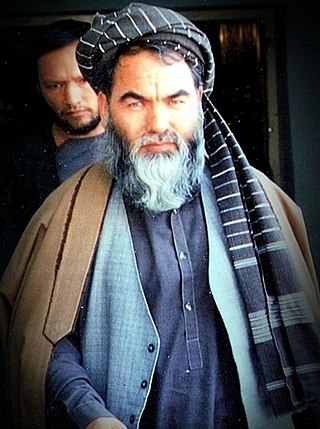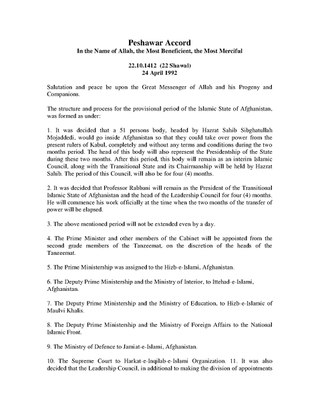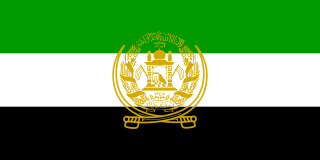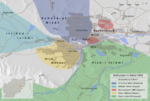
Ahmad Shah Massoud was an Afghan military leader and politician. He was a powerful guerrilla commander during the resistance against the Soviet occupation during the Soviet–Afghan War from 1979 to 1989. In the 1990s, he led the government's military wing against rival militias; after the Taliban takeover, he was the leading opposition commander against their regime until his assassination in 2001.

Gulbuddin Hekmatyar is an Afghan politician, and former mujahideen leader and drug trafficker. He is the founder and current leader of the Hezb-e-Islami Gulbuddin political party, so called after Mohammad Yunus Khalis split from Hezbi Islami in 1979 to found Hezb-i Islami Khalis. He has twice served as Prime Minister during the 1990s.
The following lists events that happened during 1996 in Afghanistan.

This article on the history of Afghanistan covers the period from the fall of the Najibullah government in 1992 to the end of the international military presence in Afghanistan.

Abdul Ali Mazari was an Afghan Hazara politician and leader of the Hezbe Wahdat during and following the Soviet–Afghan War, who advocated for a federal system of governance in Afghanistan. He believed that this would end political and ethnic division in Afghanistan by guaranteeing rights to every ethnic group. He was allegedly captured and murdered by the Taliban during negotiations in 1995. In 2016, he was posthumously given the title "Martyr for National Unity of Afghanistan" and had a statue erected in his honor by the Islamic Republic of Afghanistan. Shortly after reclaiming power, the Taliban demolished the statue.

The Islamic Dawah Organization of Afghanistan is a political party in Afghanistan led by Abdul Rasul Sayyaf. Founded in the early 1980s as the Islamic Union for the Liberation of Afghanistan, it was originally an attempt to bring unity amongst Islamist opposition forces in Afghanistan. However, the creation of the new umbrella organization effectively created a split and the organization became a political party of its own. The organization was part of the 'Peshawar Seven', the coalition of mujahedin forces supported by the United States, Pakistan and various Arab states of the Persian Gulf in the war against the PDPA government, Soviet forces and Ba'athist Iraq. Through the financial aid received from Saudi sources, the organization was able to attract a considerable military following. Arab volunteers fought in the militia forces of the organisation.

Jamayat-E-Islami, sometimes shortened to Jamiat, is a predominantly Tajik political party and former paramilitary organisation in Afghanistan. It is the oldest and largest functioning political party in Afghanistan, and was originally formed as a student political society at Kabul University. It has a communitarian ideology based on Islamic law. During the Soviet–Afghan War and the following Afghan Civil War against the communist government, Jamiat-e Islami was one of the most powerful of the Afghan mujahideen groups. Burhanuddin Rabbani led the party from 1968 to 2011, and served as President of the Islamic State of Afghanistan from 1992 to 2001, in exile from 1996.

Sibghatullah Mojaddedi was an Afghan politician, who served as Acting President after the fall of Mohammad Najibullah's government in April 1992. He was the first leader to call for armed resistance against the Soviet-backed regime in 1979 and founded the Afghan National Liberation Front at the time; later becoming a respected figure among the various Afghan mujahideen. He served as the chairman of the 2003 loya jirga that approved Afghanistan's new constitution. In 2005, he was appointed chairman of the Meshrano Jirga, upper house of the National Assembly of Afghanistan, and was reappointed as a member in 2011. He also served on the Afghan High Peace Council. Mojaddedi is considered to have been a moderate Muslim leader.

The 1989–1992 Afghan Civil War, also known as the FirstAfghan Civil War, took place between the Soviet withdrawal from Afghanistan and the end of the Soviet–Afghan War on 15 February 1989 until 27 April 1992, ending the day after the proclamation of the Peshawar Accords proclaiming a new interim Afghan government which was supposed to start serving on 28 April 1992.

The 1992–1996 Afghan Civil War, also known as the Second Afghan Civil War, took place between 28 April 1992—the date a new interim Afghan government was supposed to replace the Republic of Afghanistan of President Mohammad Najibullah—and the Taliban's conquest of Kabul establishing the Islamic Emirate of Afghanistan on 27 September 1996.
The Afshar Operation was a military operation in Afghanistan that took place on February 11–12, 1993 during the Afghan Civil War (1992-96). The operation was launched by Ahmad Shah Massoud and Burhanuddin Rabbani's Islamic State of Afghanistan government and the allied Abdul Rasul Sayyaf's Ittehad-i Islami paramilitary forces against Gulbuddin Hekmatyar's Hezbe Islami and Abdul Ali Mazari's Hezbe Wahdat militias in the densely populated, Qizilbash-majority, Afshar district in west Kabul. The Hazara-Hezbe Wahdat together with the Pashtun-Hezbe Islami of Hekmatyar had been shelling densely populated areas in northern Kabul from their positions in Afshar, killing thousands. To counter the shelling, government forces attacked Afshar in order to capture the positions of Wahdat and its leader Mazari, and to consolidate parts of the city controlled by the government.

The Battle of Kabul was a series of intermittent battles and sieges over the city of Kabul during the period of 1992–1996.
The following lists events that happened during 1992 in Afghanistan.

The Afghan mujahideen (Pashto: افغان مجاهدين) were Islamist resistance militias that fought the Democratic Republic of Afghanistan and the Soviet Union during the Soviet–Afghan War and the subsequent First Afghan Civil War.

Baba Jan zahid, is a former senior security official of the Afghanistan government. He was a general of the Democratic Republic of Afghanistan, but after the Soviet invasion he joined Ahmad Shah Masoud's forces and fought against the Soviet invasion. After the retreat of the Russian forces, he continued the war against Dr. Najibullah's government. Following the collapse of Najib's government, he entered Kabul with Ahmad Shah Masoud's forces and served in various departments of the Islamic State of Afghanistan under the leadership of Ustad Burhanuddin Rabbani.

The Shura-e Nazar was created by Ahmad Shah Massoud in 1984 at the northern provinces of Takhar, Badakhshan, Balkh and Kunduz, during the Soviet-Afghan War. It comprised and united about 130 resistance commanders from 12 northern, eastern and central regions of Afghanistan.

The Afghan conflict refers to the series of events that have kept Afghanistan in a near-continuous state of armed conflict since the 1970s. Early instability followed the collapse of the Kingdom of Afghanistan in the largely non-violent 1973 coup d'état, which deposed Afghan monarch Mohammad Zahir Shah in absentia, ending his 40-year-long reign. With the concurrent establishment of the Republic of Afghanistan, headed by Mohammad Daoud Khan, the country's relatively peaceful and stable period in modern history came to an end. However, all-out fighting did not erupt until after 1978, when the Saur Revolution violently overthrew Khan's government and established the Democratic Republic of Afghanistan. Subsequent unrest over the radical reforms that were being pushed by the then-ruling People's Democratic Party of Afghanistan (PDPA) led to unprecedented violence, prompting a large-scale pro-PDPA military intervention by the Soviet Union in 1979. In the ensuing Soviet–Afghan War, the anti-Soviet Afghan mujahideen received extensive support from Pakistan, the United States, and Saudi Arabia in a joint covert effort that was dubbed Operation Cyclone.

Pakistan's principal intelligence and covert action agency, Inter-Services Intelligence (ISI), has historically conducted a number of clandestine operations in its western neighbor, Afghanistan. ISI's covert support to militant jihadist insurgent groups in Afghanistan, the Pashtun-dominated former Federally Administered Tribal Areas, and Kashmir has earned it a wide reputation as the primary progenitor of many active South Asian jihadist groups.

On 24 April 1992, the Peshawar Accord was announced by several but not all Afghan mujahideen parties: Gulbuddin Hekmatyar, leader of Hezb-e Islami, had since March 1992 opposed these attempts at a coalition government.

The Islamabad Accord was a peace and power-sharing agreement signed on 7 March 1993 between the warring parties in the War in Afghanistan (1992–1996), one party being the Islamic State of Afghanistan and the other an alliance of militias led by Gulbuddin Hekmatyar. The Defense Minister of Afghanistan, Ahmad Shah Massoud, resigned his position in exchange for peace, as requested by Hekmatyar who saw Massoud as a personal rival. Hekmatyar took the long-offered position of prime minister. The agreement proved short-lived, however, as Gulbuddin Hekmatyar and his allies soon resumed the bombardment of Kabul.

























